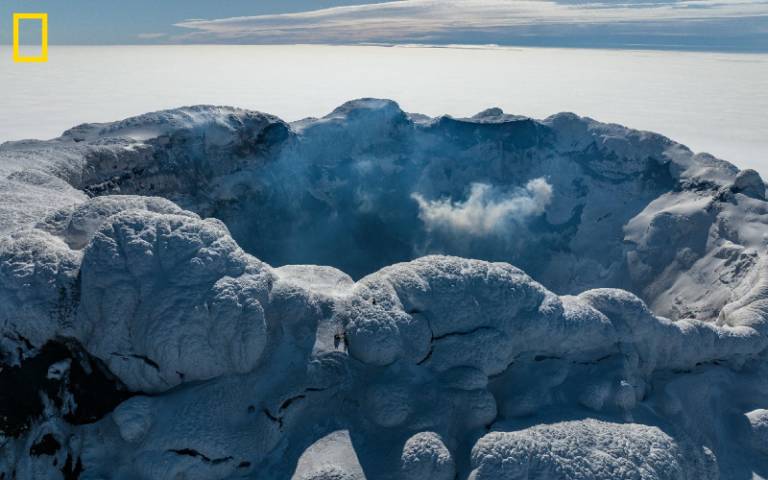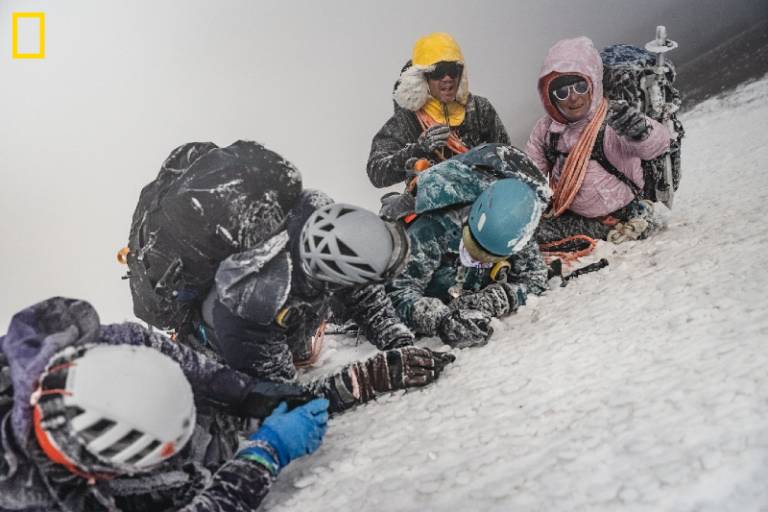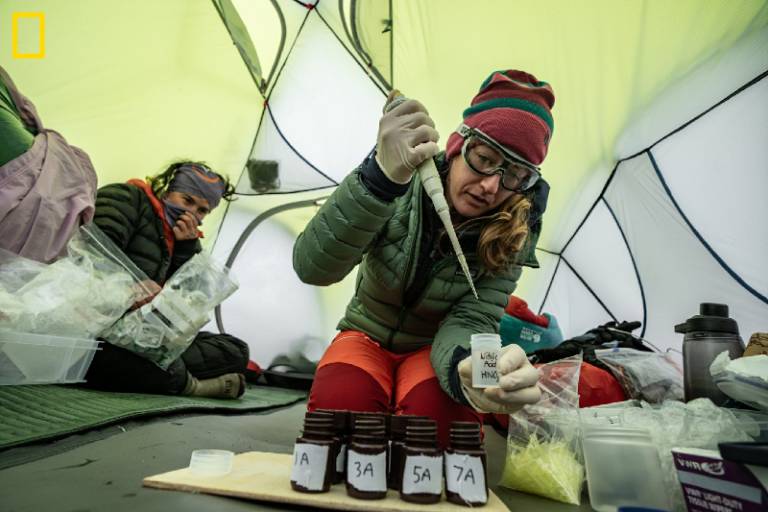Feature: UCL leads first expedition to remote island’s lava lake
23 March 2023
A team led by Dr Emma Nicholson climbed the summit of an active volcano on a remote, sub-Antarctic island, confirming the existence of a lava lake within its crater. Now they’re back, analysing their data to better understand volcanoes and their environmental impacts.

Mount Michael is a volcano shrouded in mystery. Only a handful of people have ever landed on the remote Saunders Island it sits atop, and before the expedition led by Dr Nicholson (UCL Earth Sciences), no one had ever scaled the summit. The few glimpses from space that have slipped through the almost constant cloud cover have tantalised volcanologists.
“It’s been known for several decades now that Mount Michael hosts a persistent thermal anomaly at its summit. A hotspot much hotter than the surrounding area,” Dr Nicholson said.
“We know from other ‘open vent’ volcanoes around the world that host these hotspots that they often have active lava lakes within their summit craters.”
Stable lava lakes are a rare geologic feature. They need a careful balance between the heat supplied by gas and magma from deep in the Earth and heat loss at the surface to remain molten. Out of about 1,500 active volcanoes on Earth, only seven have currently or recently hosted one, and Nicholson and her team wanted to confirm suspicions that Mount Michael was home to the eighth.
Mount Michael’s remote location and continuous outgassing also makes it an ideal natural laboratory to study how the volcano’s emissions affect the local environment. The island’s nearest inhabited neighbours are the Falkland Islands more than 1,200 miles away.
“Very few other places have such a pristine environment where you know that every trace metal that you sample in the environment has come from the volcano,” Dr Nicholson said.
The team had hoped to use some of the island’s untouched snowfall for drinking water. However, when they tested some of the nearby snowpack, they found it was deeply acidic and completely undrinkable, a clue to how much the volcano was affecting the island’s environment.
“I had expected there to be some interaction, but I never expected it to be this strong, so suddenly that became a major research focus,” Dr Nicholson said.
Saunders Island is part of the South Sandwich Islands, a volcanic archipelago stretching across about 200 miles of the Southern Ocean. These kinds of island arcs are found around the world and form where two of Earth’s tectonic plates collide and one is forced under the other.
“It’s really a window into the development of more mature arcs,” Dr Nicholson said. “The whole island arc itself is incredibly interesting because geologically it’s one of the youngest volcanic arcs on Earth.”
Island arcs like these are home to millions of people around the world. As well as shedding new light on how volcanic arcs develop over geological time, the team hopes that the lessons learned here will contribute to improving eruption forecasts and monitoring capabilities at volcanoes in populated areas.

300 feet below the summit of Mount Michael, the team takes a brief rest during their first ascent. Photograph by Renan Ozturk, National Geographic
Unfinished business
The expedition marks a triumphant return to Mount Michael for Dr Nicholson, who first visited in 2020 when she and another team of researchers sailed to several of the South Sandwich Islands. During their brief stopover at Saunders Island, they attempted to summit the volcano, but blinding whiteout conditions meant they had to turn back before reaching the peak.
“I was heartbroken at that point because that expedition had taken three years to put together,” she said. “I had put my heart and soul into it, and I knew we had that one shot and that window had closed on me.”
Despite the setback, the team collected rock samples from several islands along the arc to tell them about the type of magma being erupted and how that magma had formed.
After returning home, Dr Nicholson typed up an article about her voyage for the European Geophysical Union’s website. The National Geographic Society saw her article and contacted her in February 2022, offering to sponsor her return to Mount Michael. Over the next nine months, she worked with the society to assemble a new expedition, with a team focused on collecting gas and environmental monitoring data and achieving a first ascent of the volcano.
In November 2022, Dr Nicholson and her team of scientists, engineers and mountaineers set sail from the Falkland Islands on the 1,266-mile ocean journey to the foot of Mount Michael.
After over a week sailing across the stormy Southern Ocean, home to some of the roughest seas in the world, the team reached Saunders Island. They set up basecamp along its windswept shores and waited for the right weather window to try for the summit.
While waiting, the team collected data around the base of the volcano and set up a seismometer to record any rumblings of the Earth.
“It was such a remote and interesting place, and there has never been any seismic recording from it, so it was a unique opportunity,” said Professor Ana Ferreira (UCL Earth Sciences), who didn’t travel to the island but is analysing the seismic data and helped procure the seismometer from the University of Leicester, another partner in the expedition.
To reach the summit, the team was looking at a climb of 1,000 metres across exposed, glaciated and unfamiliar terrain obscured by fog. The island is so remote, airplanes can’t reach it in an emergency, so any medical evacuation would take days sailing back across the tempestuous ocean.
“It is a fairly unknown volcano, with a lot of crevasses, and it’s quite challenging in the fact that no one had ever been to the top,” said Dr Joao Lages (UCL Earth Sciences). “It was challenging to have a realistic risk assessment of the climb and to anticipate what the conditions would be like.”
Sub-zero temperatures, wind gusts up to 60 miles-per-hour and freezing fog while carrying hefty scientific equipment made for a strenuous climb up the slope. As they approached the peak, visibility dropped to only a few feet.
“Then, the clouds just beautifully cleared away, the winds just died down and it became this place of absolute calm and serenity; you really felt how far away from any other human you were,” Dr Nicholson said. “Standing on that summit with the team around me, personally that was one of the proudest moments of my career, and I had an amazing team to share it with.”
The team collected as much data as they could. They flew a small drone down into the crater to capture the first clear images of the small lava lake below, confirming the existence of magma at the Earth’s surface. For several hours, their gas sampler analysed plumes of carbon dioxide, sulphur dioxide, water and hydrogen sulphide seeping out of the magma.
“Scientifically everything just came together in the end,” Dr Nicholson said.

Dr Emma Nicholson adds a chemical agent to preserve melted snow samples to transport back to her lab. Photograph by Renan Ozturk, National Geographic
Many weeks of lab work
Dr Nicholson is focusing on the volcano’s environmental effects. Emitted volcanic gases and trace metals can dissolve in water droplets then return to Earth as rain or snow, something Dr Nicholson noticed in the high acidity of the snow that fell upwind of the crater. To understand how volcanic gases enter the environment through the water cycle, she’s now analysing samples collected from the island’s various water reservoirs including groundwater, fresh snow and glacier ice.
“We’re looking for volcanic pollutants like copper, lead and zinc, all of these elements that could either fertilise or be toxic in the environment,” she said. “That has big implications for water quality in volcanic areas where rainwater is a primary source of drinking water.”
Dr Lages is building a picture of the magma below the surface using the gas data combined with rock samples taken from the 2020 expedition. The composition of volcanic gases reflects the depth and pressure where they last interacted with magma, offering scientists insights into where magma is being stored and when new magma enters the volcanic system. By analysing the chemistry of the gas emitted at the crater and the tiny bits of gas locked inside solidified erupted rocks, Dr Lages is able to map out the magma “plumbing system” beneath the volcano.
“We need the deep information from rocks to model what we see at the surface,” he said.
Though their gas data suggests there’s a stable, shallow magma mass near the surface, consistent with the lava lake at the summit, other data shows Mount Michael is only a lightly slumbering giant.
“What was incredible to see when we were at the summit was the size and the steepness and dimensions of the crater,” Dr Nicholson said. “It suggests that in its history, this volcano has had a much more explosive past to really carve out that crater.”
Satellite data appear to show an ash-rich eruption in 2016, and in 2020 the team found fresh lava “bombs” on the surface of the snow. The buried seismometer also saw indications of the mountain’s restlessness.
“The volcano is definitely very active, that’s very clear from the seismic data,” Professor Ferreira said. “Even with just a few days of data, we did get quite a lot of local events.”
That it’s so active makes it an attractive site for potential future study.
“In a big majority of volcanoes, before an eruption happens, you have some sort of precursory seismic activity,” Professor Ferreira said. “You often have earthquakes occurring around volcanoes, but before eruptions they tend to have specific characteristics.”
Scientists aim to improve eruption forecasts by collecting data from more active volcanoes, of which Mount Michael is a clear target. Dr Nicholson hopes someday to return to the remote island with a suite of seismometers and gas sensors capable of satellite communications, installing them on the island to remotely monitor the volcano.
“If we can develop new technologies that are tough enough to withstand the extreme conditions, there is no limit to what we can do,” Dr Nicholson said.
Links
- Article in National Geographic (£)
- Dr Emma Nicholson's academic profile
- Dr Joao Lages’s academic profile
- Professor Ana Ferreira’s academic profile
- UCL Department of Earth Sciences
- UCL Faculty of Mathematical & Physical Sciences
Image
- Main image - Dr Emma Nicholson’s team were the first humans to reach the crater atop the remote volcano, Mount Michael. Photograph by Renan Ozturk, National Geographic
Media Contact
Mike Lucibella
- E: m.lucibella [at] ucl.ac.uk
 Close
Close

